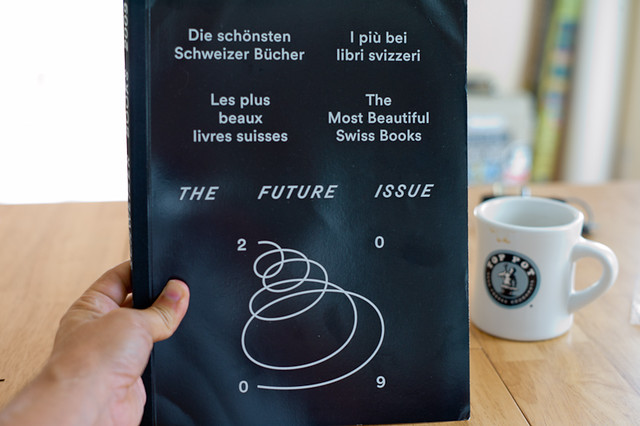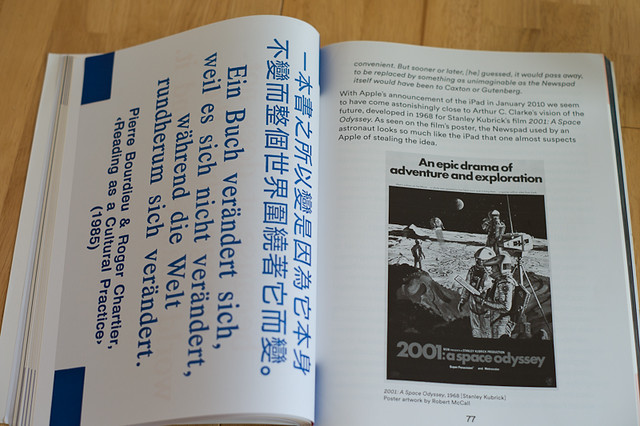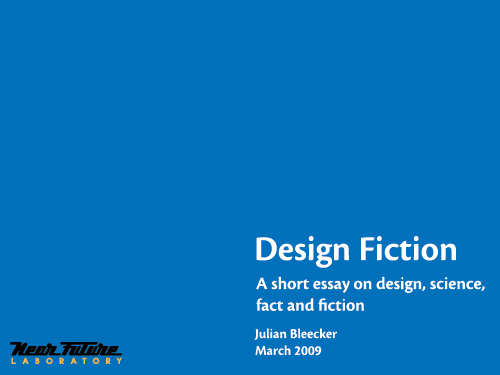And I decided to pimp my new moleskine. Satisfied. ((That’s Pod C from 2001: A Space Odyssey, btw..))
Tag: 2001: A Space Odyssey
Design Fiction Chronicles: The Future Issue of The Book and iPad
In a project we’re currently undertaking that has allowed us to work through and figure out the future of the photo book I was compelled to read through this book called “The Most Beautiful Swiss Books” and the 2009 edition is called “The Future Issue.”
I like the play on words there and didn’t see it until just now.
The Future Issue. Like..it’s the issue from 2009, because this is an annual. But, the future is an issue to consider. Get it? Well..I didn’t until my coffee took hold.
There are a few relevant passages in here on design, the future of reading and publishing and that sort of thing.
* Everyone seems to be considering the iPad. This book was published after the iPad was announced but before it was made available. There should be a follow on to the points made in there. Maybe I’ll do that. Follow up with the critics and ask them. There is the usual bulwark, which is to say that there is something about the tangibility and materiality of the book that is precious, seminal and defines book. Something that people would still want.
Other points related to iPad-mania were to indicate the distinction between book-dedicated readers like Kindle and platforms like iPad in that there is always something available with the iPad to do other than read, which can pose distractions like..*shrug..why not check email now?
There was some excitement about the evolution of book design in the pad-electronic form. What compliments and extends paper, pages, binding and all that.
* And then there was the wonderful canonical reference to 2001 – A Space Odyssey which made me very happy. I had never noticed in the movie poster that there is an iPad, which was referred to as a Newspad in the book
upon which the film was based. Bonus design fiction future issues!

* Mention was made to Wim Wenders seeking opinion on the extinction of movies in the context of the intrusion of television. Would books suffer the same fate as movies did when television appeared?
* Perhaps the most vibrant short essay questioned the phrase The future of. Something called “Experimental Jetset” — a collective of Graphic Designers in Amsterdam wrote that they dislike the three words “The future of..” saying they find “something about the phrase that completely puts us off.”
What bothers us most is the suggestion that the future is an unchangeable entity, something that develops completely independent of ourselves. A pre-determined path, to which we should adapt ourselves, whether we like it or not..
‘Our future’, is something that is manageable, shapeable, changeable, buildable, doable. ‘A future’ sounds pretty decent as well. A plural ‘the futures’? Why not? Just as long as we can get rid of the idea of the future as something that governs us, like some kind of pre-modern deity. Let us be reckless about it: we govern the future, not the other way around.
Perhaps this is the most encouraging perspective in the essays of the book, tucked neatly in near obscurity amongst the two other possible opinions: (1) veiled conceit for the iPad/nostalgic death-grip on the smell of leather, the artisinal bookbinders craft, &c.; (2) curious exuberance for this evolution in the rituals of reading.
Why do I blog this? Notes on opinions about the evolution of book writing, making and the cultural evolutions of reading and publishing practices. Plus the bonus design fiction chronicle on the iPad in 2001!
Continue reading Design Fiction Chronicles: The Future Issue of The Book and iPad
Design Fiction: A Short Essay on Design, Science, Fact and Fiction
A couple of years ago, in a small discussion group while I was teaching at USC, Paul Dourish presented an early draft of a paper he and Genevieve Bell were working on. If you read this blog, you probably know the paper. It’s called ” ‘Resistance is Futile’: Reading Science Fiction Alongside Ubiquitous Computing.” It’s a wonderful paper for a number of reasons. What is most wonderful, for the purposes of this dispatch, is the clever way the paper creates a conceptual linkage through science-fiction-ubiquitous-computing. The idea that “science fiction does not merely anticipate but actively shapes technological futures through its effect on the collective imagination” and “Science fiction visions appear as prototypes for future technological environments” — well..this is really juicy stuff.
(Their paper is generally around in draft form, for better or worse, thanks to the Google. It’s forthcoming in the Journal of Personal and Ubiquitous Computing, which is generally only readily available to academics and researchers with access to pricey journals.)
Paul asked myself and a number of people to consider writing something like a response or further considerations kind of thing that could sit alongside the article’s publication. I started in on this last summer. Ultimately, for reasons that became clear as I was writing the essay, I decided that there would be more to be said than would be tolerated in a staid, expensive, peer-reviewed academic journal, never mind that there could possibly be a wider conversation beyond the ubicomp community as my thinking ran into film, design, fan culture and unanticipated other places.
The short bit I wrote ended up as “Design Fiction: A Short Essay on Design, Science, Fact and Fiction.” It’s available as a downloadable PDF, out there in the on The Near Future Laboratory’s modest puff of Internet Cloud. (Its various incarnations as slideshows and talks can be found here on Slideshare.)

What is this all about?
Extending this idea that science fiction is implicated in the production of things like science fact, I wanted to think about how this happens, so that I could figure out the principles and pragmatics of doing design, making things that create different sorts of near future worlds. So, this is a bit of a think-piece, with examples and some insights that provide a few conclusions about why this is important as well as how it gets done. How do you entangle design, science, fact and fiction in order to create this practice called “design fiction” that, hopefully, provides different, undisciplined ways of envisioning new kinds of environments, artifacts and practices.
I don’t mean this to be one of those silly “proprietary practices” things that design agencies are fond of patenting. This is much more aspirational than that sort of nonsense. It’s part an ongoing explanation of why The Near Future Laboratory does such peculiar things, and why we emphasize the near future. The essay is a way of describing why alternative futures that are about people and their practices are way more interesting here than profit and feature sets. It’s a way to invest some attention on what can be done rather immediately to mitigate a complete systems failure; and part an investment in creating playful, peculiar, sideways-looking things that have no truck with the up-and-to-the-right kind of futures. Things can be otherwise; different from the slipshod sorts of futures that economists, accountants and engineers assume always are faster, smaller, cheaper and with two more features bandied about on advertising glossies and spec sheet.
Design Fiction is making things that tell stories. It’s like science-fiction in that the stories bring into focus certain matters-of-concern, such as how life is lived, questioning how technology is used and its implications, speculating bout the course of events; all of the unique abilities of science-fiction to incite imagination-filling conversations about alternative futures. It’s about reading P.K. Dick as a systems administrator, or Bruce Sterling as a software design manual. It’s meant to encourage truly undisciplined approaches to making and circulating culture by ignoring disciplines that have invested so much in erecting boundaries between pragmatics and imagination.

AIAA Houston Section newsletter, April 2008.
When you trace the knots that link science, fact and fiction you see the fascinating crosstalk between and amongst ideas and their materialization. In the tracing you see the simultaneous knowledge-making activities, speculating and pondering and realizing that things are made only by force of the imagination. In the midst of the tangle, one begins to see that fact and fiction are productively indistinguishable.
Design is about the future in a way similar to science fiction. It probes imaginatively and materializes ideas, the way science fiction materializes ideas, oftentimes through stories. What are the ways that all of these things — these canonical ways of making and remaking and imagining the world — can come together in a productive way, without hiding the details and without worrying about the nonsense of strict disciplinary boundaries?
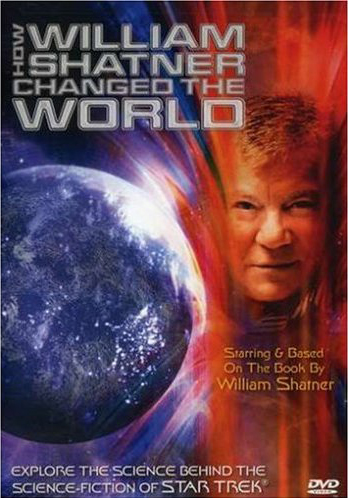
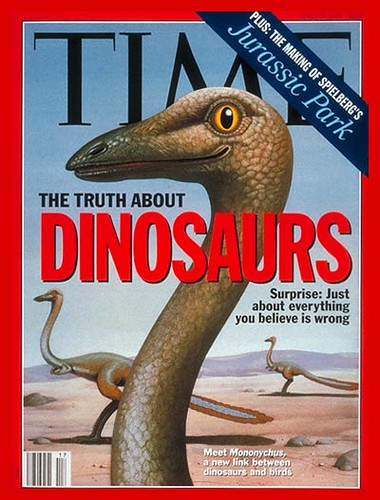
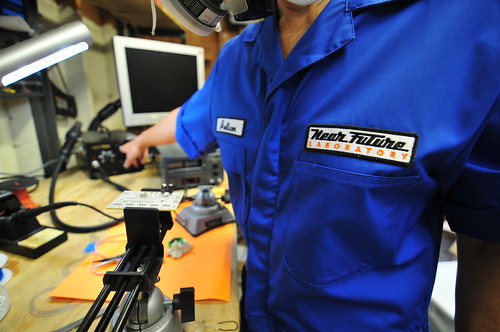
I’ve written more about this, from some conversations with friends and colleagues last fall. It’s here, in this PDF called “Design Fiction: A short essay on design, science, fact and fiction.” It started at that discussion group with Paul in 2005 or 2006, and evolved into something I presented last fall at the Design Engaged ’08 workshop in Montreal, then the SHiFT 08 conference in Lisbon last October, then at the Moving Movie Industry conference, finally at the O’Reilly ETech 2009 conference.
Subsequently, this topic has been taken up in a variety of forms and venues. Bruce Sterling has a wonderful essay on the topic in the ACM Interactions journal. And I organized a panel at South by Southwest 2010. with Bruce, Sascha Pohflepp, Stuart Candy and Jake Dunagen with Jennifer Leonard doing an excellent job of wrangling and moderating. (The video should be available in a month or so from mid-March 2010.)
By request, here is a Design Fiction Printable Edition that will print on normal, human paper, to scale on 8.5×11.
Why do I blog this? A written kind of design provocation. For the last several months, there’s been a bit more word cobbling than wire soldering. The two practices contribute to the same set of objectives, which is to make and remake the world around us, provide new perspectives and evolve a set of principles that help make the making more imaginative, more aspirational.
I should also add that, when I was writing my master’s thesis on Virtual Reality some time ago (it’d have to be ‘some time ago’ for that topic), I wrote about science fiction meeting science fact, which was some of the earliest inspiration for this work, shared by the laboratory imaginary of the grad student “cyberfreaks” in the University of Washington HITLab and our reading/re-reading of Gibson’s Neuromancer during the early 1990s. Not just Neuromancer but all kinds of science fact/fiction. The simultaneity of the science fiction and the military science fact that was the first Gulf War. I wrote about that, too, because I was being taught by the guy who made that military technology, which was an unpleasant experience, but one from which I learned a great deal about how fact and fiction can swap properties. That same curiosity led to further interest in visual stories and their role in understanding and making sense of the world around us, especially in science fiction film and video games. I wrote a dissertation on this, studying with Donna Haraway, err..when I was a young lad in 1993-95. Therein was a chapter on Jurassic Park as simultaneously science fact and fiction. We had plenty of lively discussions specifically on this film. (Sarah Franklin was visiting at UCSC then and wrote some really amazing stuff about science fiction and genetics out of that, back in the late 90s that appears in “Global Nature, Global Culture.”) There was a seminar paper I did on “Until the End of the World”, looking at the Sony Design concepts Wim Wenders used to create a compelling science fact within the science fiction diegesis. In there was one of the earliest bits of video game commentary (SimCity 2000) from a critical theory perspective, not that I care about ordinality, but some folks seem to. There was a chapter on the SGI Reality Engine, ILM and Special Effects in science fiction (mostly Jurassic Park, which brought me to David Kirby’s early work – he’s the guy who coined this phrase ‘diegetic prototypes’, btw) and science fact showing the techniques and technologies that allow media to cross from fiction to fact. And so on. In many ways, this essay is a continuation of these interests and one I share with a great deal of friends, colleagues and complete strangers, I’m sure. Lots of people are playing around in here, excitedly and eagerly swapping ideas and stories. It’s a conversation that’s usually quite energetic and fun. If the ideas herein intersect and entangle with yours, it means you’re a healthy, creative individual, aspiring for a better near future we all hope to one day to live within. It’s a waste of my time to say things like — yes, I’m working on that. Yes, I have been working on this while you were in grammar school. And to do this every time someone mentions something you are also thinking on? That’s just preposterous. I used to do that with students, or point out to them someone who has also been working on something they think they have thought about for the first time. Inevitably, for the younger students who think they’re the only ones in the world who thought about such-and-so idea — they shrink and pout and get petty and don’t realize that they are in a world of ideas and their uniqueness is in the doing, not the clamoring to be Sir Edmund Hillary climbing that hill for the first time. That’s an ancient, sick model of intellectual and creative cultural production. It’s a world of circulation these days, with knots and rhizomes and linkages between lots of activities.
And that’s all I have to say about that.
Upload Cinema – Visions of a Future

via erwinvanderzande
An interesting proposition — show shorts that are found online, like on YouTube or Vimeo or wherever in a proper, normal, human bricks & mortar theater. That’s what Upload Cinema in Amsterdam does and, darnit..if I was there, I’d go every month.
Update: The viewed films can be seen online now.
On February 2, 2009 they will be showing short films and clips according to the theme “Visions of a Future” which I had the good fortune to be the guest editor and curate, along with a few other folks. Part of the duties I agreed to was to provide some introduction. As I’m not in Amsterdam and am someplace rather warmer and drier, I cobbled together a rash-dash video introduction which doesn’t say much, but sets the mood.
Upload Cinema Visions of a Future Intro from Julian Bleecker on Vimeo.
I had an evening, after a day in the studio, to put this together and I really have no video production skills and, on top of that, my aspirations were pretty high. I thought about what I might say that would tie the event to my design fiction thinking, but that’d mean pulling together a few remarks and I thought it’d be more fun to be fun.
The high concept, which — after a few test compositions and some editing and rendering I realized would take me into the wee hours of the morning — is that the Odyssey from 2001: A Space Odysseyhas a custodian/superintendent who is called Hal and misunderstandings between him and HAL evolve from there when Hal, the Super, overhears Dave and Frank talking about disconnecting HAL.
Anyway..I blame the Porto.
